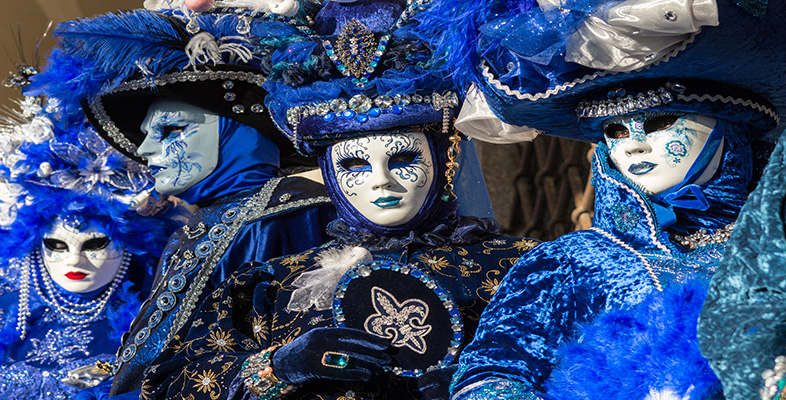4 Some history paintings
Venetian trade, together with the colonies of merchants established throughout the eastern Mediterranean, meant a constant interplay and importation of ideas and stories as well as objects, textiles and raw materials into Venice itself. The result of the merging of thousands of individual responses was a distinctively inflected society bearing witness to ‘the profound cultural impact of centuries of trade with the Islamic world’. 58 Towards the end of the fifteenth century, and in the early years of the sixteenth, an ‘oriental mode’ became prominent in Venetian pictorial art. In this section I want to look at some examples of this art, but I shall begin with two images of the heart of the city, or rather its hearts plural: the political and religious focus on Piazza San Marco, with the Palazzo Ducale and the Basilica, and the economic and commercial centre of the Venetian empire at Rialto.
I have already touched on the nature of Venetian society, and the way in which a collective ethos held sway. Although nineteenth-century claims about the emergence of a modern sense of the individual as a key to the nature of the Florentine Renaissance are now regarded with scepticism by contemporary historians, the Venetian relationship of the individual to the collective does seem to have been distinctive. The ethos of the ordered totality, enshrined in the ‘Myth of Venice’, encompassing a multiplicity of distinctions, but encompassing and subsuming them nonetheless, is what underwrites the very particular representation embodied in Gentile Bellini’s Procession in the Piazza San Marco of 1496 (Figure 23). Bellini’s piazza is dominated by the façade of the basilica of San Marco, in front of which a procession makes its way from right to left. It might be said that the top half of the picture testifies to the force of the Byzantine and the Gothic in Venice. The domes of the church and the golden mosaics of its portals speak of Byzantium. But interspersed with the Byzantine is the northern – in the form of the Gothic pinnacles at either end and between the pointed arches. The Gothic theme continues in the arches of the Doge’s Palace, visible to the right of the basilica; Islamic influence is apparent in the pink and white lozenge-shapes of its decorative tile work. This lack of fortification on its seat of government, the large windows and the pervasive decoration serve to underline Venetian pre-eminence: a city so powerful, so replete with divine grace, that it did not need walls.
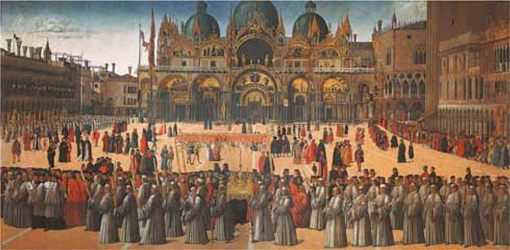
Bellini’s picture was originally painted for the meeting room of the Scuola Grande di San Giovanni Evangelista, whose members process across the front of the square. The organised quality of the painted representation stands unequivocally for the ordered nature of Venetian society – its diversity rendered equal in the sight of the church. The doge is one of a crowd, halfway along the right-hand side of the square. The other scuole have finished their processions and are drawn up in orderly fashion to the left. The middle of the picture offers nothing less than ‘a demographic cross-section of Venice’. 59 Along with ladies, gentlemen and citizens in recognisable costumes can be seen a group of German merchants in the middle distance to the right of the canopy, four Greek merchants in their distinctive black-brimmed hats standing in the middle of the square to the left; in the distance, in front of the basilica to the right are three turbaned Turks. In the row of first-floor windows along the far left of the square, well-dressed women, two of them apparently veiled in Islamic style, look out from balconies, over which are draped more than 30 rich oriental carpets.
The real subject of the picture is, however, none of this urban spectacle. Or rather it is all of it, in balance with a single defining motif of divine intervention in the secular domain. The point of the commission as a whole, of all nine paintings in the scuola’s great albergo, or meeting room, is to commemorate the Miracles of the True Cross. Throughout Renaissance Europe, and nowhere more so than in Venice, holy relics marked the borders of the mundane and the divine – in fact the miracles they performed were the proof of the presence of the divine in the material world below. The Scuola di San Giovanni Evangelista’s prize possession was a fragment of the True Cross, donated in the previous century by the Grand Chancellor of Cyprus, who had in turn received it from the Patriarch of Constantinople. The albergo itself was in effect the frame for the wooden fragment housed in its gold reliquary, which was taken out and borne in procession on key feast days – such as the one depicted here: 25 April, the feast day of Saint Mark, patron saint of Venice. The key figure is a merchant from Brescia, in Venice for the vigil, and doubtless also on business. While there, he receives notice of a near fatal accident to his son. The boy will not survive. The merchant, just visible through a gap in the procession to the right of centre, kneels and prays to God for his son’s survival as the relic of the True Cross passes by. On his return to Brescia, he finds the boy healed: a miracle. God’s presence in the world is confirmed again. This is what Bellini represents: the divine at work in the cosmopolitan life of Venice.
Something of the same holds for another picture originally part of the same cycle in the Scuola’s meeting room, painted by Vittore Carpaccio two years earlier (Figure 24). Here, Carpaccio depicts another miracle, this time in the economic and commercial heart of Venice, the Rialto, adjacent to the busy Grand Canal. Once again the key to the picture is displaced to the margins, the sacred being embedded in the flow of secular life. At the far left, in the first-floor loggia, an exorcism is taking place. A possessed man is being healed by the miracle-working fragment of the True Cross, as commercial and social life rolls on with barely a blink. Another varied cast of characters is discernible. Along the bank of the canal, immediately before the bridge, can just be seen the columns of an open loggia where the merchants met. Outside it, two white-turbanned figures in long robes, one white, one orange, can just be made out. In the foreground, at the far left, in black-brimmed hats and sumptuous brocade robes, stand figures thought to be Armenian or Greek merchants. And unmissable, right in the centre foreground and acting as a kind of counter-focus to the decentred miracle, is a working man, albeit no ordinary workman: a distinctively attired African gondolier. This gondolier was most likely a slave. 60
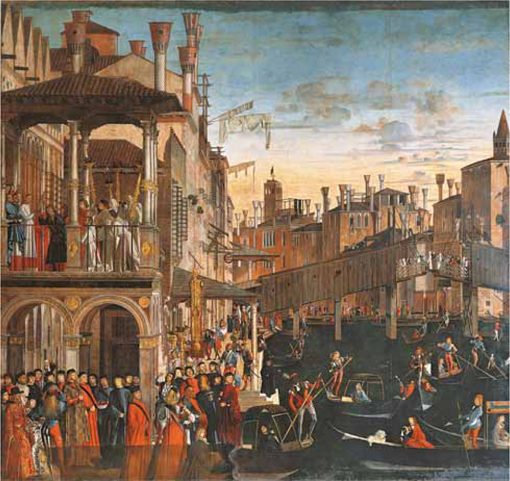
Venice had traded in slaves since at least the tenth century, probably earlier. 61 Most were Christians, often described as ‘Tartars’ or ‘Circassians’ from the area around the Black Sea. After the fall of Constantinople, there was a decline in this Black Sea slave trade (not that the traffic died out – they were simply used by the Ottomans), and an increase in the use of black slaves from Africa. These numbers increased further in the sixteenth century as European attitudes turned against the enslavement of fellow Christians, and increasing Ottoman power militated against the use of Muslim slaves. It has been calculated that in the late fifteenth century perhaps 1,500 negro slaves were being traded annually at Venice. 62 By 1600, however, Venetian slavery had died out – not least because of competing demand from Portuguese, Spanish, Dutch, British and French colonies, as well as the Muslim states. After that time freed slaves continued to live in Venice, mostly though not exclusively working as domestic servants. Although Africans were never as numerous as other communities, such as Jews, Turks and Germans, the imagery of black people entered into Venetian popular culture and has never really left it (as the Fred Wilson installation mentioned at the start of this chapter testifies).
In the Scuola di San Giorgio degli Schiavoni, the fondaco of the merchants from Dalmatia, between 1502 and 1508 Carpaccio painted three scenes from the life of Saint George as part of an overall scheme of nine pictures. Whereas the two paintings from San Giovanni Evangelista represent the diversity of Venetian society itself, these pictures form part of an overtly ‘oriental mode’ in Venetian art. The narrative mode as a whole functioned to represent the ‘Myth of Venice’ back to Venetians themselves, a visual counterpart to the historical chronicles which narrated the city’s foundation and prosperity. 63 In the late fifteenth century, contemporary political developments seem to have stimulated artists to address a newly pressing theme, namely the ‘Other’ to Venice’s imperium in the shape of expansionist Islam. In these works certain Venetian artists ‘attempted to reproduce an Islamic setting, with figures dressed in Muslim garb, exotic animals – camels, monkeys and giraffes – and, on occasion, architecture of Islamic inspiration’. 64 In contrast to Bellini’s portrait of Mehmet II, or his individual costume studies, these pictures involve a conscious attempt to imagine an oriental culture and society.
The representation of the world of Islam takes, however, a specific form. One curious feature of this development is that Venetian artists seem to have shied away from representing contemporary Ottoman society as such. Whereas verbal reports on Ottoman society abounded, and although isolated Ottoman figures can be found in Venetian art, sometimes situated in the heart of Venice itself, there are no images of the lived environment of the Ottoman world. What there are, however, are plentiful images of the early Christian world of the Holy Land. And in the late fifteenth and early sixteenth centuries the Holy Land lay not in Ottoman territory but in the empire of the Mamluks, the other eastern Mediterranean Islamic culture, based in present-day Syria and Egypt. So Venetian artists, representing the trials and victories of the early Christian Church, imagined them against a partly factual, partly made-up background of known architecture and non-Christians in Mamluk costume.
Thus, Carpaccio’s The Triumph of Saint George (Figure 25) shows a miscellaneous crowd of Mamluk figures witnessing the triumph of the Christian knight against a background of buildings based on woodcut images of the Dome of the Rock and the Church of the Holy Sepulchre in Jerusalem. Traditionally, the Saint George story was set in the Eastern Christian Empire, including Palestine. The dragon motif was established in the thirteenth-century Golden Legend, wherein the killing of the dragon results in the conversion of the people to Christianity. It does not take an enormous leap of the imagination to read the dragon that is about to succumb to George’s coup de grâce as a figure for the pagan unbelief that the Church is poised to overcome. This reading is reinforced in the final painting of the series, Saint George Baptising the Pagans (Figure 26). To the left, musicians wearing the Mamluk zamt, a tufted bonnet, stand on a plinth covered in an Islamic carpet; to the right, conspicuously bare-headed figures are baptised into the Christian faith, their elaborate Mamluk headgear cast aside at the foot of the stairs they have mounted.
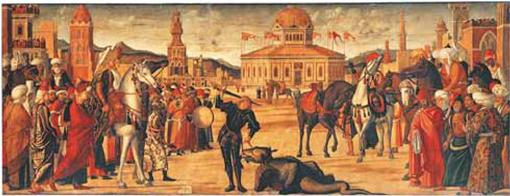

The meeting house of the Dalmatian confraternity of Saint George was in a building owned by the Knights of Saint John of Jerusalem, themselves a crusader organisation. The Dalmatians had been in the frontline of the Venetian struggle against the Turks in the Adriatic, and their presence in Venice marked them as, essentially, refugees from Ottoman expansion. The occasion of the commission to decorate the meeting room was their receipt of an important relic of Saint George in honour of their exploits under the flag of Venice. This was a gift from the commander of the Venetian forts in Dalmatia before they fell to the Turks in 1499, who in turn had received it from no less a figure than the Patriarch of Jerusalem. It can readily be seen, therefore, how the Saint George legend of the defeat of pagan unbelief by the action of a virtuous Christian knight becomes a resonant motif at a point where Venetian Christian culture perceives itself threatened by the apparently unstoppable expansion of the Islamic Ottoman Empire.
A similar cluster of concerns underwrites the enormous painting by Gentile Bellini of Saint Mark Preaching in Alexandria (Figure 27). This picture turned out to be Gentile’s last, and although the design and most of the actual work is his, some of the foreground figures and the buildings to right and left of the central square were completed after his death by his brother Giovanni. The Scuola Grande di San Marco had been rebuilding its premises after a fire in 1485, and Bellini put himself forward to decorate the albergo as early as 1492. The commission, however, was not finalised until 1504, by which time Bellini had behind him the success of his Procession in the Piazza San Marco. The new painting was intended to evoke that earlier triumph, and was indeed ‘specifically cited as the standard which he promised to surpass’. 65 The added ingredient in this commission, of course, is that Saint Mark is the patron saint of Venice itself. Preaching to the infidel (and, indeed, dying for the cause) represents a powerful ideological message in early sixteenth century Venice.
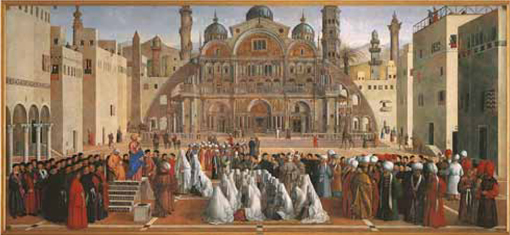
This was not the first work to dramatise Saint Mark’s attempts to win over the infidels in a plausibly Egyptian setting: precedence goes to a project of the late 1490s by Cima da Conegliano and Giovanni Mansueti for the silk-weavers guild. Indeed, Mansueti (active 1485–1526/7) went on to work on the Scuole di San Marco commission after Gentile’s death, with three further orientalising paintings on episodes from the life of Saint Mark (Figure 28). Mansueti’s rather cluttered paintings draw on what was by then an established repertoire of motifs, including a variety of eastern headgear and the Mamluk coat of arms, albeit set in unlikely classical architecture. By contrast, in the grandeur of its conception and coherence of design, Gentile’s picture of Saint Mark Preaching in Alexandria represents a culmination of the orientalist mode in Venetian painting. Taken in conjunction with the Procession in the Piazza San Marco, it represents a kind of mapping of Venice onto its ‘Other’: the Piazza San Marco onto the Alexandrian plaza, the basilica onto the imaginary pagan temple. It is as if by assimilating the exotic – and threatening – to the familiar, the all-too real threat of the Islamic ‘Other’ could be negotiated and absorbed at the level of the imagination.
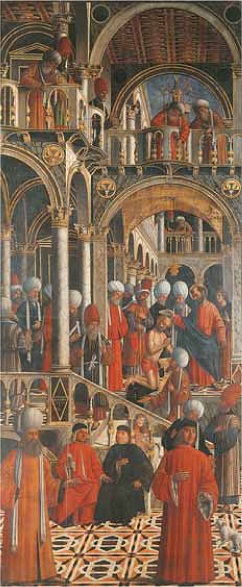
In his pioneering work on Venetian Orientalism, Julian Raby investigated a number of possible sources for this complex imagery of Islamic society that was fashioned by Venetian artists. 66 ‘Fashioned’ is an appropriate term because such images are not the product of direct experience. Gentile Bellini seems to have been the only major artist to have travelled to the East, and that was 20 years earlier; in addition to which, his journey was made to Ottoman Constantinople and not to Mamluk Alexandria. As already noted, Bellini did not produce any large-scale image of Ottoman society from his visit, and none exists by any other hand. However, in addition to individual portraits and costume studies by Gentile and Costanzo, another important visual resource was provided by the German woodcuts of Erhard Reuwich (1455–c.1490). These accompanied Bernhardt von Breydenbach’s Peregrinationes, an account of his pilgrimage to the Holy Land in 1483, published three years later in Mainz (Figure 29).

Yet another important source of oriental imagery is an arresting picture (now in the Louvre) by an unknown artist. The city of Damascus was an important trading centre, situated at the end of an Asian caravan route, as well as a staging post for western pilgrims en route to the Holy Land. In The Reception of an Ambassador in Damascus (Figure 30), both the clothing and the architecture show that the painting represents a Mamluk scene. The turbans are not Ottoman: they include the bearskin-type hats of the military, the large, often white, turbans lacking the Ottoman tāj in the middle, and the elaborate horned, so-called ‘waterwheel’ turban – used for example by Mansueti in his Saint Mark series of paintings. Despite the Mamluk clothing, however, the location of the Reception long remained unidentified, and was in fact mistaken for Cairo because of its compatibility with a verbal description of such a reception there. Now, however, the dome and minarets of the Great Umayyad Mosque have been identified, and other features, such as the bathhouse in the centre, with glass tiles in its dome, the walled garden and rooftop terraces, all bespeak first-hand knowledge of such a scene. Indeed, it has been suggested that the mosque was viewed from the Venetian merchants’ fondaco itself. Local colour is provided by the authentic costumes, the Mamluk insignia on the walls and gateway, and, not least, the camels and palm tree. The focus of the scene is an official reception by the Mamluk viceroy of Damascus (shown seated on a low platform with two other dignitaries behind him) of a Venetian ambassador (standing in a red gown with other black-clad Venetians to the left of the gateway). The Damascus Reception has long been considered the single most important source for the Venetian oriental mode of Carpaccio, Cima, Mansueti, Gentile and others. However, recent research indicates it may follow, rather than predate, these works (perhaps even made by a member of Gentile’s workshop). The precise relationship of the pictures remains a matter of interpretation, and a salutary reminder of the uncertainties still attendant on Renaissance art history. As recently as 2002, one author has Venetian painters selecting their ‘authenticating details’ from the ‘compendium’ offered by the Louvre picture. 67 Yet in 2005 it has been described as ‘clearly by a follower of Gentile … working in his manner’. 68 Such uncertainty over the date of the Louvre picture or over the authorship of the Ottoman figure studies serves to underline the often provisional nature of historical knowledge – an uncertainty heightened when the objects of our knowledge are remote, not only in time but in space, that is, geographically and culturally.
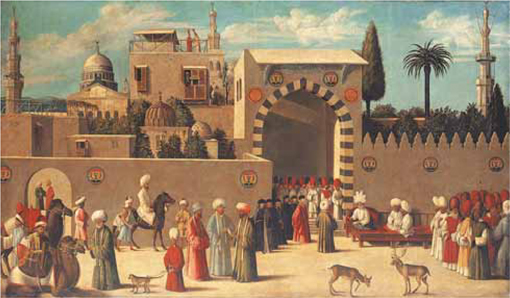
However the question of sources is decided, it is clear that Venetian artistic orientalism depended on a relatively limited repertoire of images, some representing quite distant ‘translations’ of some actual, originary, observation. Gentile Bellini’s Saint Mark Preaching in Alexandria (Figure 27) is one such example. In it Bellini uses similar motifs to those in the Louvre painting, including three figures in the bottom right corner, as well as the palm tree in the right middle distance, and many of the Mamluk turbans. His white-veiled figures are derived from the Reuwich woodcuts. The man standing directly before Saint Mark, apparently paying close attention to his preaching, is in Ottoman costume. At the very front of the composition, perhaps posthumously emphasised by his brother Giovanni, who completed the painting, stands Gentile Bellini himself in an imposing bright-red gown, wearing a gold chain given to him by Mehmet II. The picture is thus a composite put together to produce a convincing effect of an oriental scene. Many of the architectural details are topographically accurate: the pillar in the right-hand background is the Column of Diocletian in Alexandria, known as ‘Pompey’s pillar’ and marking the site of a pagan temple destroyed by early Christians; the top of the famous Pharos lighthouse, one of the ‘Seven Wonders of the World’, appears at the far left; the obelisk to the left of the central temple had been brought to Alexandria by the Roman Emperor Augustus from Heliopolis. 69
One of the defining features of Saint Mark Preaching in Alexandria, rather than its circumstantial detailing, is of a somewhat different order: it is an imaginative recycling of Bellini’s own previous masterpiece. The composition of the piazza flanked by the receding orthogonals of the side buildings (these apparently rendered plainer by Giovanni), the band of figures across the foreground, parallel to the picture plane, but above all the fantastic temple dominating and defining the scene as ‘Other’, are all adapted from the Procession in the Piazza San Marco. The façade, with its arches and domes, unmistakably evokes the basilica of San Marco, shorn of its Gothic tracery, but with the addition of enormous curving buttresses. Probably drawing on a visual memory of Hagia Sophia, which Gentile would have seen in Constantinople a quarter of a century earlier, as well as on the Venetian San Marco, this formidable synthesis serves to situate the scene in a realm at once exotic and familiar. In sum, the giant picture with its hundreds of figures and colossal architecture aspires to nothing less than a displaced affirmation of Christian Venice’s sway over the realm of the infidel – imagined, moreover, at precisely the moment when that actual hegemony was threatened as never before.
